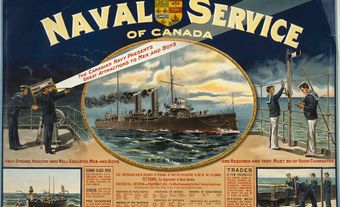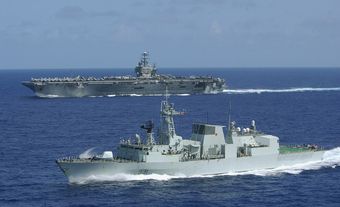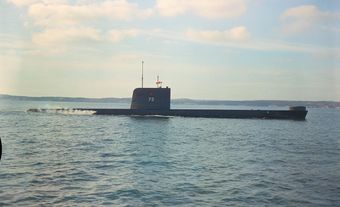The Canadian Towed Array Sonar System (CANTASS) has been used by Canadian ships since the late 1980s for long-range detection and identification of submarines. It is a passive system that “listens” but does not transmit any noise. The CANTASS uses a hydrophone array developed by the US Navy in conjunction with a powerful signal processor developed by Litton Systems Canada Ltd. The CANTASS has been fitted to the Annapolis-class destroyers, Halifax-class frigates, and the Oberon and Victoria-class submarines.

Towed Array Sonar
In the 1960s, the United States Navy (USN) achieved a major technological breakthrough, adapting the passive sonar hydrophone arrays of the SOSUS network (mounted on the ocean bottom) for use by surface ships as a towed array sonar system. The array is a long cable fitted with microphones that is towed up to two kilometres behind the ship. Hull-mounted sonar systems were affected by the noise generated by the ship itself and were limited in range. The towed array sonar system promised detection ranges in the tens of kilometres (direct path) and even hundreds of kilometres (convergence zone), as compared to only thousands of metres for active sonar.
CANTASS
The Canadian towed array sonar system (CANTASS / AN/SQR-501) was developed and tested in the 1980s. It comprises a “wet end” USN AN/SQR-19 hydrophone array, augmented by the powerful AN/UYS-501 “dry end” signal processor by Litton Systems Canada. Like the active variable-depth sonar (VDS), it is used beneath the ocean surface thermal layer that can prevent signals being heard by hull-mounted sonars. As a passive sonar, the hydrophone array “listens” for broadband and discrete frequencies; the powerful computer processor can identify frequencies from particular submarines and point to the bearing from which they originate. Two or more CANTASS spaced a distance apart can triangulate bearings to pinpoint the source of the submarine noise. This information allows a fast response from shipborne helicopters or land-based aircraft such as the CP-140 Aurora.

 Share on Facebook
Share on Facebook Share on X
Share on X Share by Email
Share by Email Share on Google Classroom
Share on Google Classroom


